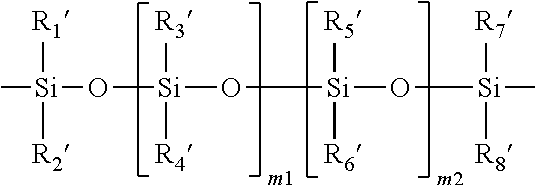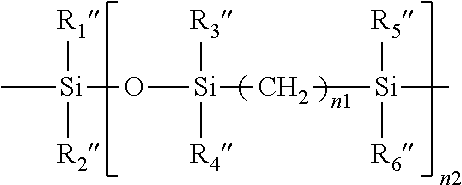Method for producing contact lenses with durable lubricious coatings thereon
- Summary
- Abstract
- Description
- Claims
- Application Information
AI Technical Summary
Benefits of technology
Problems solved by technology
Method used
Image
Examples
example 1
Oxygen Permeability Measurements
[0171]The apparent oxygen permeability (Dkapp), the apparent oxygen transmissibility (Dk / t), the intrinsic (or edge-corrected) oxygen permeability (Dkc) of a lens and a lens material are determined according to procedures described in Example 1 of U.S. patent application publication No. 2012 / 0026457 A1.
Digital Rubbing Tests.
[0172]The lenses are digitally rubbed (wearing disposable powder-free latex gloves) with RENU® multi-purpose lens care solution (or another multi-purpose lens care solution) for 20 seconds and then rinsed with saline. The above procedure is repeated for a given times, e.g., from 1 to 30 times, (i.e., number of repetitions of digital rubbing tests which imitate cleaning and soaking cycles).
Lubricity Evaluation.
[0173]The lubricity rating is a qualitative ranking scheme where 0 is assigned to control lenses coated with DAILIES® TOTAL1® commercial lenses, 1 is assigned to OASYS™ / TruEye™ commercial lenses and 4 is assigned to commercial...
example 2
[0177]Phosphate Solution (0.2%, pH 2). A phosphate solution (0.2%, pH 2) is prepared by dissolving 2 grams of sodium phosphate dibasic dehydrate in 998 grams of DI water and the pH is adjusted to 2.0 by adding 1N HCL.
Phosphate Solution (0.1%, pH 2). A phosphate solution (0.1%, pH 2) is prepared by diluting from the Phosphate Solution (0.2%, pH 2) prepared above.
Bicarbonate Solution (0.2%, pH 10). A bicarbonate solution (0.2%, pH 10) is prepared by dissolving 2 grams of sodium bicarbonate in 998 grams of DI water and the pH is adjusted to 10.0 by adding 1N NaOH.
Bicarbonate Solution (0.1%, pH 10). A bicarbonate solution (0.1%, pH 10) is prepared by diluting from the Bicarbonate Solution (0.2%, pH 2) prepared above.
TBO Stock Solution (2000 ppm). A TBO stock solution (2000 ppm) is prepared by dissolving 0.04 gram of Toluidine Blue 0 (TBO) (from Sigma Aldrich) in 20 grams of DI water.
TBO Staining Solution (50 ppm). A TBO staining solution (50 ppm) is prepared by diluting the TBO Stock So...
example 3
Preparation of CE-PDMS Macromer
[0178]In the first step, α,ω-bis(2-hydroxyethoxypropyl)-polydimethylsiloxane (Mn=2000, Shin-Etsu, KF-6001a) is capped with isophorone diisocyanate (IPDI) by reacting 49.85 g of α,ω-bis(2-hydroxyethoxypropyl)-polydimethylsiloxane with 11.1 g IPDI in 150 g of dry methyl ethyl ketone (MEK) in the presence of 0.063 g of dibutyltindilaurate (DBTDL). The reaction is kept for 4.5 h at 40° C., forming IPDI-PDMS-IPDI. In the second step, a mixture of 164.8 g of α,ω-bis(2-hydroxyethoxypropyl)-polydimethylsiloxane (Mn=3000, Shin-Etsu, KF-6002) and 50 g of dry MEK are added dropwise to the IPDI-PDMS-IPDI solution to which has been added an additional 0.063 g of DBTDL. The reactor is held for 4.5 h at about 40° C., forming HO-PDMS-IPDI-PDMS-IPDI-PDMS-OH. MEK is then removed under reduced pressure. In the third step, the terminal hydroxyl-groups are capped with methacryloyloxyethyl groups in a third step by addition of 7.77 g of isocyanatoethylmethacrylate (IEM) and...
PUM
| Property | Measurement | Unit |
|---|---|---|
| Temperature | aaaaa | aaaaa |
| Temperature | aaaaa | aaaaa |
| Temperature | aaaaa | aaaaa |
Abstract
Description
Claims
Application Information
 Login to View More
Login to View More - R&D
- Intellectual Property
- Life Sciences
- Materials
- Tech Scout
- Unparalleled Data Quality
- Higher Quality Content
- 60% Fewer Hallucinations
Browse by: Latest US Patents, China's latest patents, Technical Efficacy Thesaurus, Application Domain, Technology Topic, Popular Technical Reports.
© 2025 PatSnap. All rights reserved.Legal|Privacy policy|Modern Slavery Act Transparency Statement|Sitemap|About US| Contact US: help@patsnap.com



